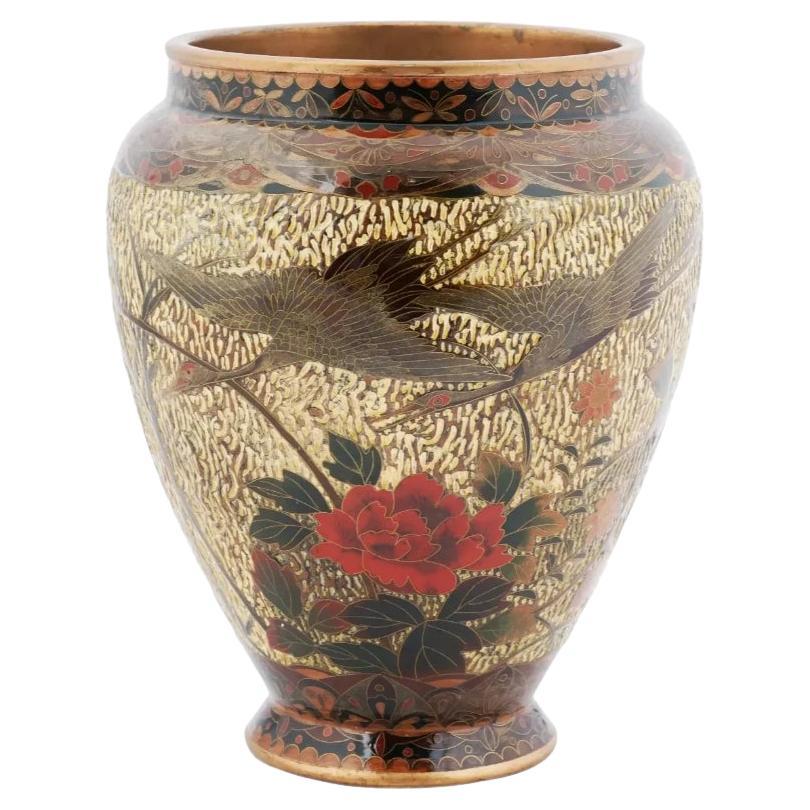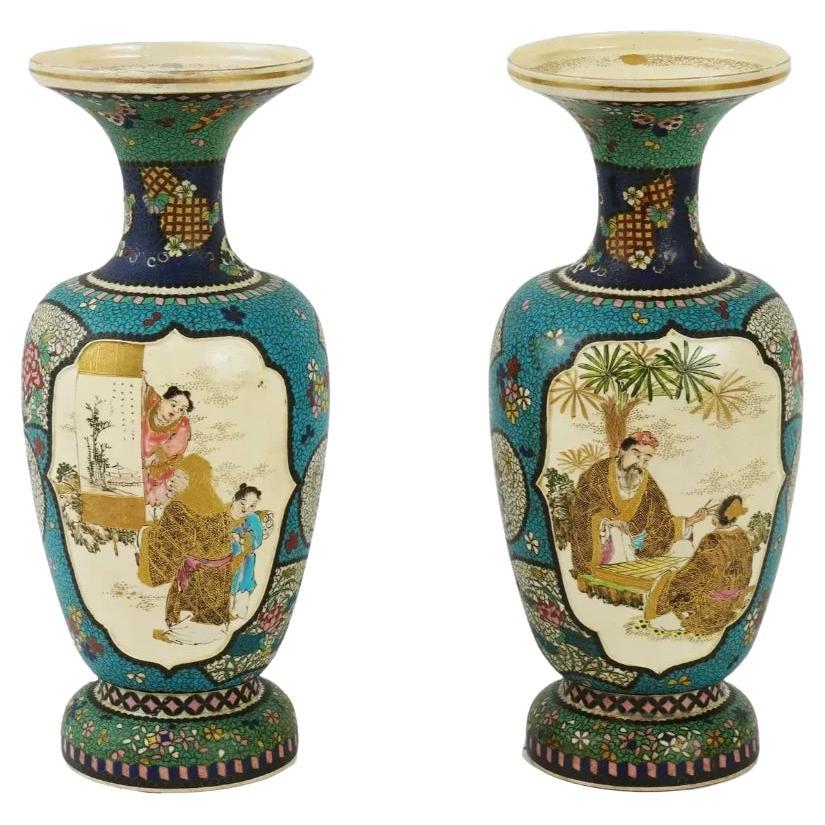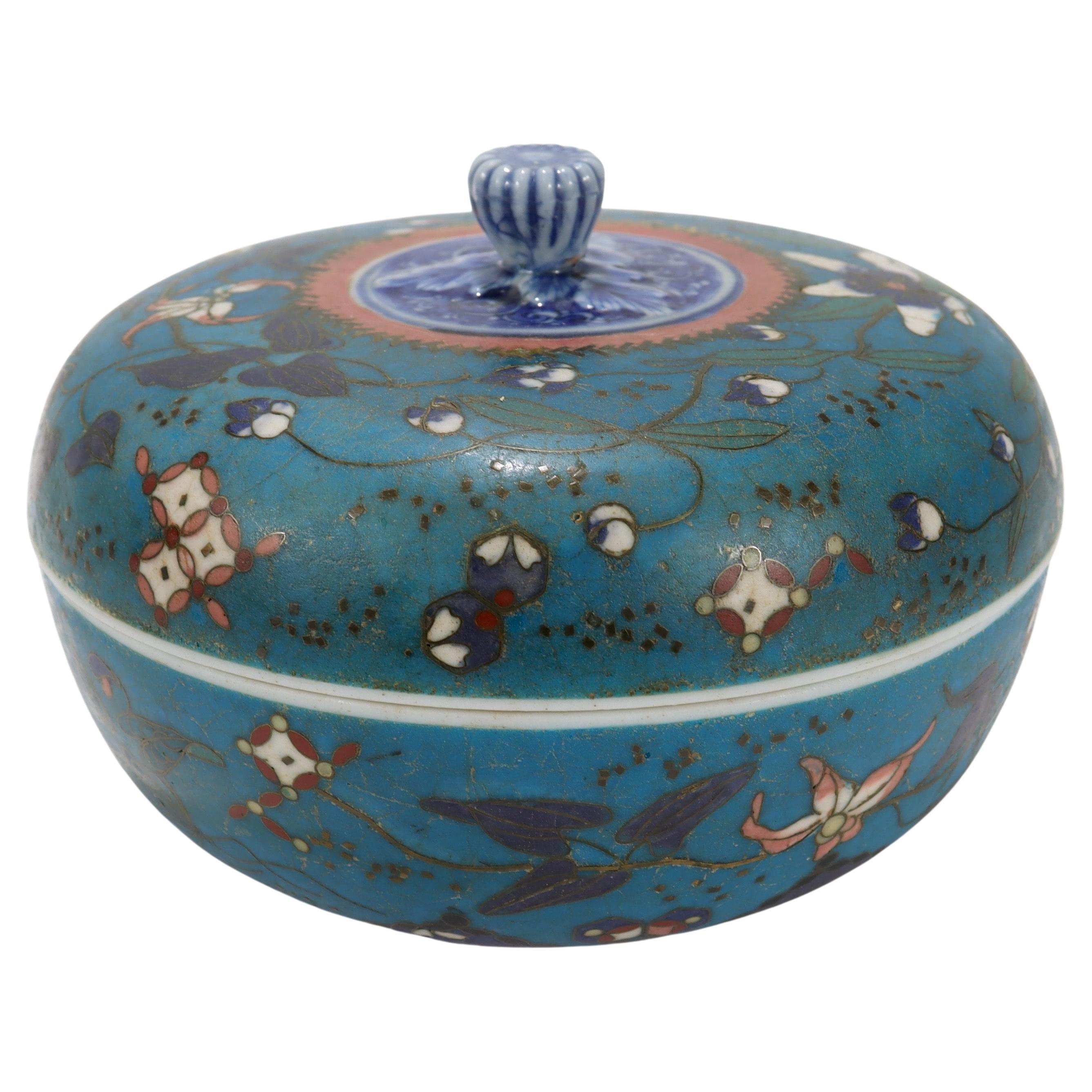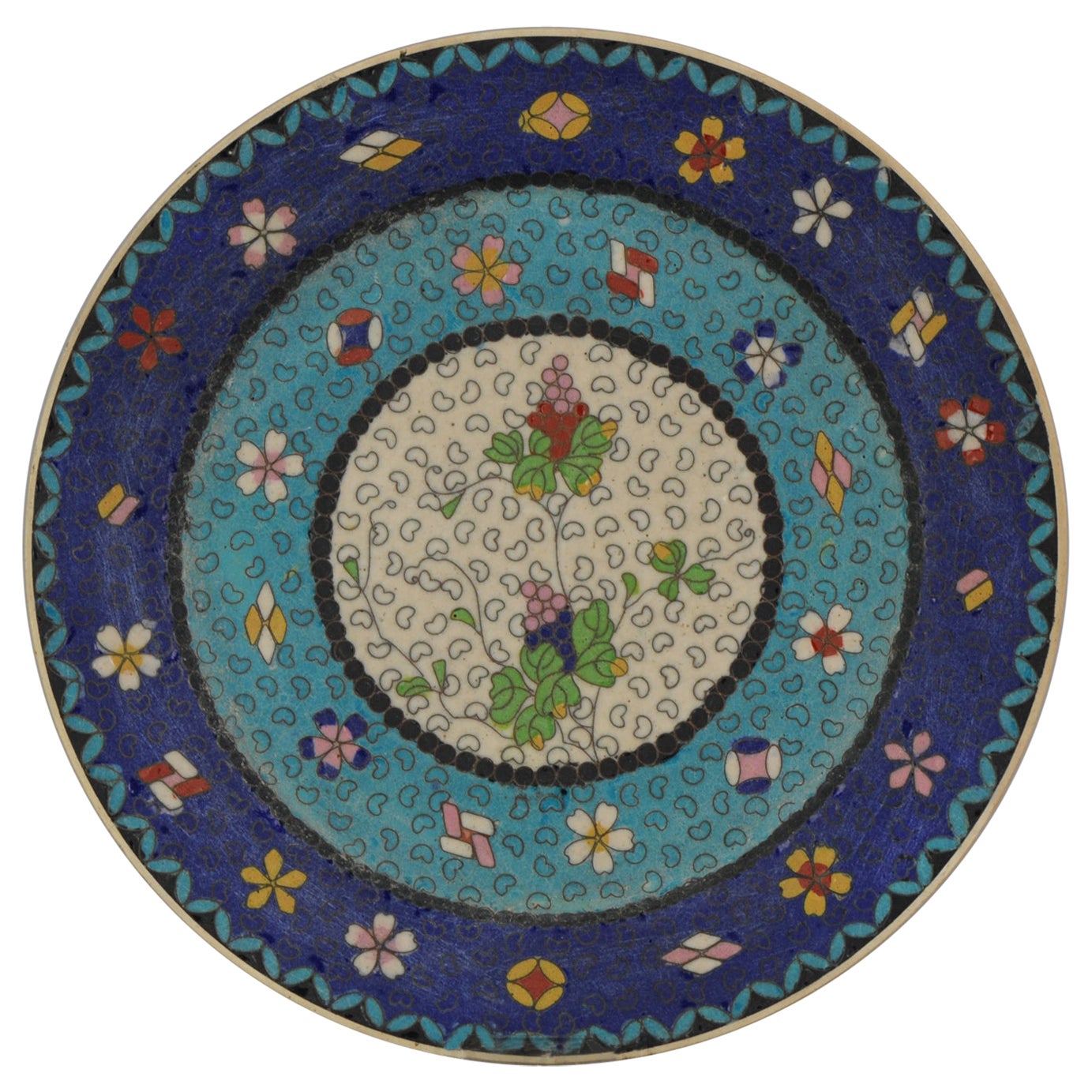Items Similar to Rare Kinkozan Totai Shippo Japanese Cloisonne on Porcelain Bottle
Want more images or videos?
Request additional images or videos from the seller
1 of 8
Rare Kinkozan Totai Shippo Japanese Cloisonne on Porcelain Bottle
About the Item
An antique Japanese Meiji era, 1868 to 1912, Totai Shippo cloisonne enamel and porcelain sake bottle. Decorated with finely detailed birds, flowers and butterflies in turquoise blue field, two cream medallions on the recto and verso side, banded neck design, fine wire work. Comes with an original lid. Signed on the bottom with Japanese characters: Japan, Kyoto, Made by Kinkozan. Kinkozan was a well known studio operating in Kyoto during the late Meiji period. Totai Shippo is the broad descriptive term for cloisonne on ceramics, earthenwares, and porcelain. It has the appearance of metallic cloisonne ware, however some parts of the surface might be left decorated as normal blue an white porcelain.
Dimensions: Overall size: H 11 in. All measurements are approximate.
Condition
Overall good vintage condition. Refer to photos.
- Dimensions:Height: 11 in (27.94 cm)Diameter: 10 in (25.4 cm)
- Style:Meiji (Of the Period)
- Materials and Techniques:
- Place of Origin:
- Period:
- Date of Manufacture:Late 19th Century
- Condition:Wear consistent with age and use.
- Seller Location:New York, NY
- Reference Number:1stDibs: LU7386239658342
About the Seller
4.9
Platinum Seller
These expertly vetted sellers are 1stDibs' most experienced sellers and are rated highest by our customers.
1stDibs seller since 2022
49 sales on 1stDibs
Typical response time: <1 hour
- ShippingRetrieving quote...Ships From: New York, NY
- Return PolicyA return for this item may be initiated within 14 days of delivery.
More From This SellerView All
- Kinkozan Japanese Cloisonne Enamel Totai Scholars Satsuma Signed VasesLocated in New York, NYA large pair of antique Japanese Totai Shippo cloisonne enamel and Satsuma porcelain vases, Meiji era, 1868 to 1912. Of a baluster form, on the body is painted with butterflies to to...Category
Antique Late 19th Century Japanese Meiji Vases
MaterialsEnamel
- Meiji Japanese Totai Cloisonne Enamel Ceramic JarLocated in New York, NYAn antique Japanese late Meiji era covered Totai enamel on ceramic ginger jar. Circa: late 19th century to early 20th century. The ware is enameled with a polychrome fan shaped medallions with blossoming flowers, bamboo trees, grapes, surrounded by a geometrical pattern made in the Cloisonne technique. The cover of the ware is decorated with polychrome fan shaped medallions with blossoming flowers. The neck and the lid are adorned with polychrome geometrical, and swirl motifs made in the same technique. Signed with red ink hieroglyphs, on the bottom. Totai Shippo...Category
Antique Late 19th Century Japanese Meiji Jars
MaterialsEnamel
- Meiji Japanese Totai Cloisonne Enamel Porcelain BoxLocated in New York, NYAn antique Japanese late Meiji era covered Totai enamel on porcelain trinket or jewelry box. Circa: late 19th century to early 20th century. The ware is enameled with a polychrome floral medallion with butterflies and berries, on the top of the cover, surrounded by floral, and foliage patterns made in the Cloisonne technique. A hand painted image of a flower, under the cover. Dated, 01.12.08, and probably numbered, 6, on the bottom. Totai Shippo...Category
Early 20th Century Japanese Meiji Decorative Boxes
MaterialsEnamel
- Large Antique Japanese Cloisonne Enamel on Porcelain Totai Jar SignedLocated in New York, NYA large antique Japanese late Meiji era covered Totai enamel on porcelain ginger jar. Circa: late 19th century to early 20th century. The ware is enameled with a polychrome fan shape...Category
Antique Late 19th Century Japanese Meiji Metalwork
MaterialsEnamel
- Antique Meiji Japanese Cloisonne Enamel on Porcelain Cloisonne Teapot TotaiLocated in New York, NYAn antique Japanese porcelain teapot. Early Meiji The body and lid are garnished with thin wire cloisonne decor, flowers and butterfl...Category
Antique Late 19th Century Japanese Tea Sets
MaterialsEnamel
- Rare Antique Japanese Cloisonne Enamel Porcelain Tea Set Totai SignedLocated in New York, NYAn antique Japanese enamel porcelain tea set. Features a captivating bird and floral design meticulously executed in the intricate cloison...Category
Early 20th Century Japanese Tea Sets
MaterialsEnamel
You May Also Like
- Japanese Totai Shippo Porcelain Covered BoxLocated in Philadelphia, PAA fine Japanese porcelain box. Decorated to the exterior with a dark turquoise enamel ground with floral decorations. The figural finial as wel...Category
20th Century Japanese Meiji Ceramics
MaterialsEnamel
- Antique Japanese Totai Shippo Cloisonné on Satsuma Plate Japanese, 19th CenturyLocated in Amsterdam, Noord HollandA Japanese Totai Shippo cloisonne (cloisonné ) pottery plate. The plate has the usual cream coloured body that is normally associated with satsum...Category
Antique 19th Century Chinese Decorative Dishes and Vide-Poche
MaterialsPorcelain
- Large Japanese Satsuma Ceramic Vase KinkozanBy KinkozanLocated in Atlanta, GAA large Japanese ceramic vase from the end of Meiji period circa 1890-1910s by Kinkozan (1645-1927). One of the largest studio manufacturers of the export ceramics at the time based in Kyoto. In the typical style of satsuma made at the turn of 20th century, the vase is elaborately decorated with a rather unusual kinran-de (gold paint) and green enamel highlight on a mottled brown background. The painterly decoration depicts a large seasonal floral arrangement in a circular fashion. Besides the obviously superb craftsmanship, what sets this particular vase apart from many lower quality and mass-produced pieces is its tone-on-tone color pallet that is visually somber and the small and sensitive details that heralds the change of the seasons. When the viewer goes beyond the first casual glimpse of the blossom and foliage, one would notice that on the edges of certain leaves as well as along the stalks, there accumulates a very thin layer of the white dust that represents the frost. The flower in bloom are chrysanthemums. Despite of being splendid, they are the messengers of the autumn. The large lotus leaf was subtly rendered in a bended and slightly withered manner, just past its prime. Although the lotus is still in bloom, the prominent seed pod indicates it may be the last for the season. The sentimental capture of the change of the seasons is not unusual in Japanese art. This vase poetically represents such a subtle transition from summer to fall, perhaps depicting the very first frost. The neck of the vase is also slightly unusual with two rolled rings...Category
Early 20th Century Japanese Meiji Ceramics
MaterialsCeramic
- Fine Japanese Ceramic Satsuma Vase by KinkozanBy KinkozanLocated in Atlanta, GAA miniature Japanese ceramic vase from the end of Meiji period circa 1880s- 1910s by Kinkozan (1645-1927). One of the largest studio manufacturers of the export ceramics at the time ...Category
Early 20th Century Japanese Meiji Ceramics
MaterialsCeramic
- Japanese Pair Meiji Cloisonne Bottle Vases with Scattered Floral DesignsLocated in Bishop's Stortford, HertfordshireA fine pair Japanese Meiji period cloisonne bottle shaped vases decorated with scattered floral patterns and dating between 1868 and 1912. The vases are lightly made standing on a fl...Category
Antique 19th Century Japanese Meiji Metalwork
MaterialsBrass
- 4 Japanese NASCO Porcelain Sake BottlesLocated in Norton, MA4 Japanese NASCO Porcelain Sake Bottles, Mid-20th century. Green drip-glazed porcelain with cork-lined stopper. Some of the cork has deteriorated. Label on bottom. Each stands 5.5" t...Category
Mid-20th Century Japanese Bottles
MaterialsStoneware
Recently Viewed
View AllMore Ways To Browse
Antique Flowers And Butterflies
Japanese Fine Porcelain
Antique Turquoise Band
Neck Wire
Japanese Porcelain Bird
Antique Japanese Porcelain Bird
Rare Japanese Porcelain
Japan Porcelain Ware
Porcelain Ware Japanese
Antique And Vintage Bottles
Antique Vintage Bottles
Bird Bottle
Vintage Antique Bottles
Antique Cream Porcelain
Japan Cloisonne Birds
Blue Butterfly Vase
Cloisonne Vase Bird
Blue And White Bottle Vase





